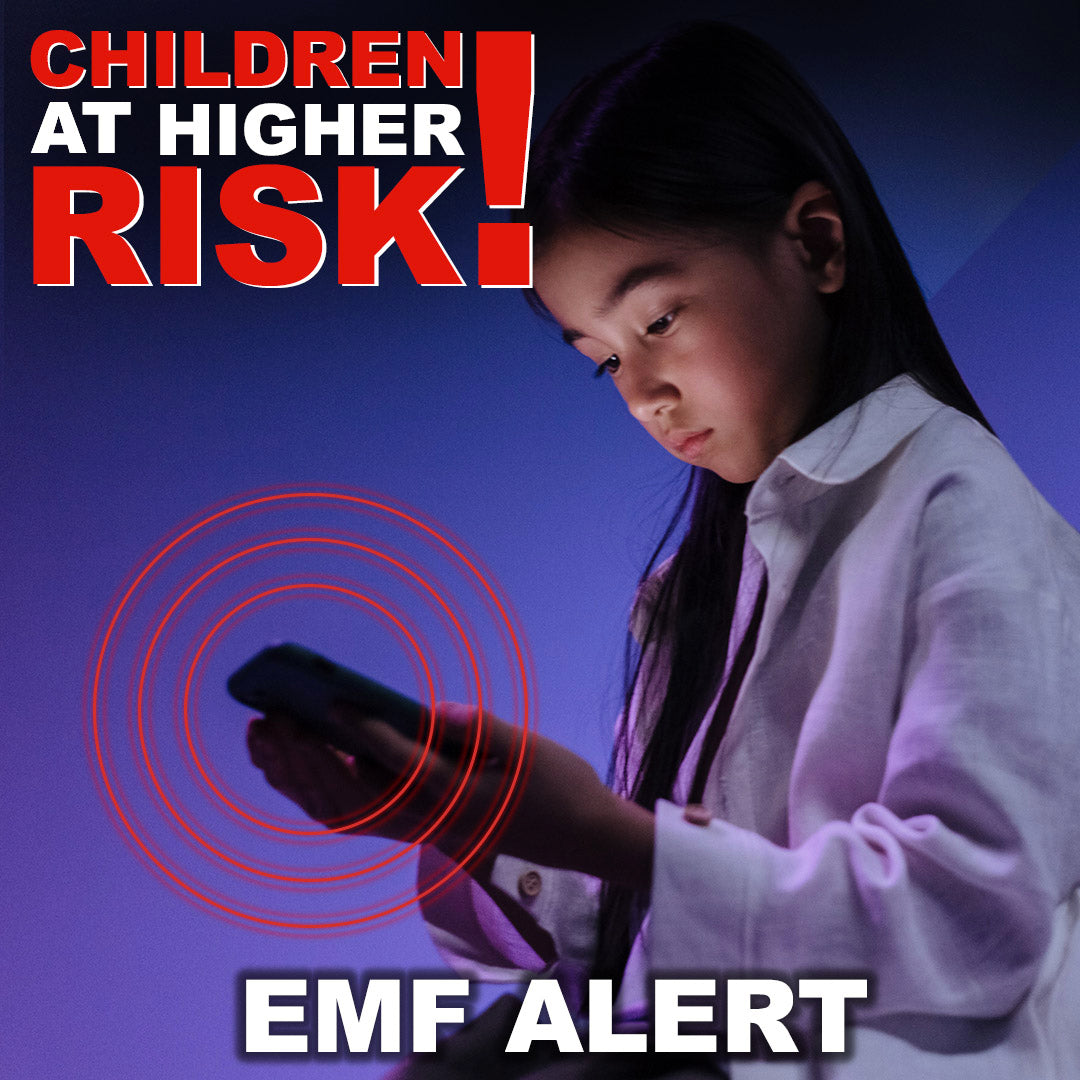EMF Radiation and ADHD in Children

What's The Connection Between ADHD in Children and EMF Radiation from Smart Devices?
EMF radiation or Electromagnetic Frequency Radiations are emitted by smart devices we use in our daily lives such as wifi routers, cell phones, laptops and microwaves are being connected to various different fatally serious health issues, from infertility to cancerous tumors
But were you aware that your kids are more vulnerable to the harmful radiations of EMFs?
Yes, young minds are still developing and hence are more susceptible to EMF radiations in all sorts of ways. Their tissues are under development stages and have a higher water content that makes their bodies more conductive to EMF radiations. And since children are always using smart tech; wether being on their cell phones 24/7, or watching TV or playing video games, it increases their exposure to EMFs now more than ever.
Your children are mostly with you. Wether you're trying to read a book in your couch or waiting in line at a supermarket, your children need your constant attention and while you're busy, giving them a tablet or cell phone to watch videos or play video games is seemingly the best option to quiet them.
However, there is a huge underlying problem invisible to us. Research and studies are now showing a strong link between electromagnetic radiations and psychological problems such as ADHD and other cognitive and behavioural disorders. The compelling connection between ADHD and EMF exposure in new studies indicate growing concerns that need urgent attention.
Let's learn about the connection between EMFs and psychological disorders in children, and see what we can do to protect them from these deadly radiations. EMFs and their correlation to Attention-Deficit/Hyperactivity Disorder (ADHD) is finally getting the attention it deserves.
What is Attention-Deficit/Hyperactivity Disorder (ADHD)?
ADHD is a common chronic mental disorder affecting cognition and behaviour including attention difficulty, hyperactivity and impulsiveness.
American Psychiatric Association states:
"Attention-deficit/hyperactivity disorder (ADHD) is one of the most common mental disorders affecting children. Symptoms of ADHD include inattention (not being able to keep focus), hyperactivity (excess movement that is not fitting to the setting) and impulsivity (hasty acts that occur in the moment without thought)."
Further,
"An estimated 8.4% of children and 2.5% of adults have ADHD
(Danielson, 2018; Simon, et al., 2009).
ADHD is often first identified in school-aged children when it leads to disruption in the classroom or problems with schoolwork. It is more commonly diagnosed among boys than girls given differences in how the symptoms present. However, this does not mean that boys are more likely to have ADHD. Boys tend to present with hyperactivity and other externalising symptoms whereas girls tend to have inactivity."
Although ADHD's symptoms seem to portray almost any youthful child, when their hyperactivity is extremely excessive for their age, these symptoms begin to affect their daily lives. School work and sleep quality can be drastically affected. If you notice such behaviour, it is advised to see a child psychologist and psychiatrist who can diagnose the disorder and recommend the best suitable treatment.
Symptoms and Diagnosis of ADHD
There are 3 main types of ADHD:
- Inattentive ( Predominantly Inattentive Presentation )
- Hyperactive ( Predominantly Hyperactive/Impulsive Presentation )
- Combined Presentation ( Inattentive + Hyperactive )
The Inattentive type has challenges with staying on task, focusing, and organization.
The Hyperactive/Impulsive type has excessive movement such as fidgeting, excessive energy, not sitting still, and being talkative. Impulsivity refers to decisions or actions taken without thinking through the consequences.
The Combined type of ADHD is diagnosed when both criteria for both inattentive and hyperactive/impulse types are met.
Parents must note their children's behaviour patterns, their attention span—how long can the child focus on a subject, for how long can they can read a book or pay attention in class, how many hours is the child able to rest and how many sessions of hyperactivity is taking place in a day, as well as noting down any other abnormal behavioural patterns that are persistently occurring over the span of several months. All this information will assist the psychologist and/or psychiatrist to diagnose the issue better and provide the best solutions individualised to your child's needs.
Is it ADHD or EMF Sensitivity?
The American Psychiatric Association states the following symptoms for children with Attention-Deficit/Hyperactivity Disorder:
- Doesn’t pay close attention to details and makes careless mistakes in school.
- Has problems staying focused on tasks or activities.
- Does not follow through on instructions and doesn’t complete schoolwork.
- Fidgets with or taps hands or feet, or squirms in seat.
- Not able to stay seated (in classroom, workplace).
- Runs about or climbs where it is inappropriate.
- Always “on the go,” as if driven by a motor.
- Talks too much.
- Unable to play or do leisure activities quietly.
Basically, children with ADHD act impulsively without thinking, are hyperactive and have a tough time focusing on anything. Even if they understand instructions they can not follow through because they can not be idle and they can not focus.
Presently, EMF-Sensitivity is another disorder that is being diagnosed more thoroughly. It is a disorder that affects the cognition of individuals who find themselves experiences fatigue, brain fog, lack of focus and memory loss—after sustained or frequent use of smart devices such cell phones, laptops and WiFi.
A noteworthy observation is that the symptoms of EMF sensitivity and ADHD are closely alike, suggesting a possible connection between these 2 disorders and that the culprit behind these conditions might be the same in a lot of cases.
Prenatal EMF Exposure and Childhood ADHD
A study was conducted by researchers of 13,000 children with behavioural problems. Their mothers were inquired about the extent of their prenatal and postnatal cell phone usage. A direct connection between the childrens' behavioural problems and their mothers' prenatal and postnatal EMF exposure was established; an 80% higher tendency for children to have behavioural, emotional, and hyperactive behaviours after prolonged pre-natal and post-natal cell phone exposure.
Researchers and scientists are now making bolder statements about the catastrophes of EMFs for childrens' brains. They have no doubts or uncertainties with their unrestrained warnings now.
© 2017 Society for Research in Child Development Inc, states:
" Mobile phones and other wireless devices that produce electromagnetic fields (EMF) and pulsed radiofrequency radiation (RFR) are widely documented to cause potentially harmful health impacts that can be detrimental to young people. New epigenetic studies are profiled in this review to account for some neurodevelopmental and neurobehavioral changes due to exposure to wireless technologies. Symptoms of retarded memory, learning, cognition, attention, and behavioral problems have been reported in numerous studies and are similarly manifested in autism and attention deficit hyperactivity disorders, as a result of EMF and RFR exposures where both epigenetic drivers and genetic (DNA) damage are likely contributors. Technology benefits can be realized by adopting wired devices for education to avoid health risk and promote academic achievement "
Why Are Childrens' Brains More Vulnerable to EMFs?
Researchers have discovered that a child's brain takes in up to 10x the amount of EMFs than adults. Major reasons that make young minds more susceptible to EMF radiations:
1. 24/7 Exposure
Children are constantly engaged with smart devices all the times. Wether it is scrolling through social media for hours, binge watching Netflix on TV or simply being in a room with 5G playing video games. All these devices emit radiations that create an atmosphere of endless e-smog. This constant exposure makes kids more prone to the detrimental behavioural effects of EMF.
2. Bone Thickness and Density
The head of a child differs anatomically in multiple ways from the head of an adult. These anatomical differences cause the brain to be more vulnerable to cell-phone radiation. The skull thickness increases as a child grows older (Smith et. al 2012). Not only does the thickness of the skull develop over time, but so does the cranial capacity. This is to accommodate for the ever growing and developing brain of the child.
The thickness of the skull of a child under the age of 1 has been shown to be between 3 and 4 mm. The skull of a 20-year-old, on the other hand, has an average thickness of 6 to 8 mm depending on the location on the skull (Delye et. al 2004). This is a significant increase in the protection provided to the brain.
Additionally, the bones have been shown to increase in density as the child gets older. The density of the skull of a child under the age of 1 is between 750 and 850 mg/cm3, whereas the density of a 20-year-old is around 1000 mg/cm3. The added thickness and density of the skull during the development of the cranium is likely due to an increased compact bone formation and decreasing amount of spongy bone tissue.
Thus, when a child is exposed to RF-EMF the compact tissue which is the protective covering is not as thick. This not only exposes the brain to RF-EMF, but it also exposes the vulnerable red bone marrow contained in the diploe in between the trabeculae to these waves. This could account for the correlation of leukemia and RF-EMF observed in children in Rome that were within a 2 km radius of base towers that communicate via RF-EMF (Michelozzi et. al 2002).
Since the compact bone is not fully developed, it leaves the marrow exposed. These waves could then potentially damage the marrow cells, creating cancerous white blood cells that interfere with the production of red blood cells. The lack of red blood cells carrying oxygen in the blood results in the devastating symptoms of leukemia. Another potential hazard of RF-EMF that can come about due to lack of bone protection is damage to the brain itself. The less radiation that the skull absorbs results in more radiation hitting sensitive brain tissue.
3. Myeline
A major anatomical difference between the brain of children and adults is the amount of myelin surrounding a neuron. Myelin is a fatty substance which surrounds neurons in the CNS and PNS.
RF-EMF can be a risk for demyelination in children whose myelin development has not been completed. Even adults whose myelin sheaths are fully developed are at risk of demyelination due to RF-EMF. The risk exists because formation of free radicals by RF-EMF can cause lipid peroxidation. This can then cause the myelin to be oxidized, resulting in the formation of a free radical chain. The demyelination results in an exposed axon that risks further damage by RF-EMF, which could potentially degenerate the axon. Demyelination can also result in slower action potentials and the decreased likelihood of PSP propagation in the post-synaptic membrane. This may be the mechanism for the lower cognition scores observed by (Dean III et. al 2015) in children with lower VF¬M¬.
Lower myelination levels can also result in the plaques of dead neurons associated with MS as demyelinated neurons die. Children whose myelin is still not fully developed in certain areas in the brain are at an increased risk of myelin and axonal degeneration. The more RF-EMF that is absorbed by the brain in a child, the more exposed the neurons can become as demyelination progresses.
How Can We Protect Our Children?
Studies show that while the head absorbs 80% of the radiation while one is talking on the phone, the head absorbs 50% of the of the radiation during gaming (Fernandez 2018). This is still a considerable amount. Especially with the current culture of letting children use cell-phones to stream movies and play games online. The effects of cell-phones, whether socially or biologically, clearly affect children. While the purpose of this paper is not to suggest that society abandon cell-phones entirely, there should be some sort of regulation for giving a cell-phone to a child, the same way there are rules regarding giving a minor tobacco or alcohol.
Ways we can help reduce EMF exposure for our children:
1. Regulate Screen Time
Have a daily limit for how much cell phone, TV, or video game time children can have.
2. Educate Children About Using Smart Devices Wisely
- Have children keep smart devices away from their bodies where they’re not directly in physical contact. Tell them to use the wired earphones or speaker phone, holding their cell phones away from their ear when listening.
- Proximity is a major factor. Have children sit a distance of at-least 6 ft. away from the TV and other smart devices.
- Keep laptops off children's laps. Use tables instead.
3. Use EMF Protection Devices
Essential Energy Solutions is all about EMF protection. We have designed and developed EMF blocking devices; The Essential Power Pendant and Light Towers, using advanced physics and nanotechnology that cancel the harmful radiations emitted by smart devices keeping you and your loved ones safe.
Let’s make informed decisions and enjoy our smart devices wisely and safely.








Leave a comment